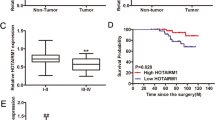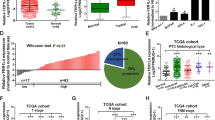Abstract
Purpose
BGL3, a novel long non-coding RNA (lncRNA) that plays a crucial role in several human malignancies. However, the clinical significance and biological function of BGL3 in papillary thyroid carcinoma (PTC) have not been explored. Herein, we aimed to investigate the role of BGL3 in human PTC.
Methods
A total of 85 pairs of PTC and normal tissues were collected for clinicopathological analysis. Expression of BGL3 was determined by quantitative real-time polymerase chain reaction (qRT-PCR). The effects of BGL3 on PTC cells ware determined by CCK-8, colony formation, EdU and wound healing assays. The molecular mechanism underlying BGL3 was tested by ChIP, Co-IP, RNA pull-down and luciferase reporter assays. In vivo experiments were conducted using xenografts in nude mice.
Results
BGL3 was significantly decreased in PTC tissues compared to adjacent normal thyroid tissues, and it was transcriptionally repressed by oncogene Myc. Low BGL3 is positively related to larger tumor size, lymph node metastasis, later TNM stage and poor prognosis. Overexpression of BGL3 inhibited PTC cell proliferation and migration in vitro, and reduced tumor size and lung metastasis nodules in vivo. BGL3 was mainly located in the cytoplasm, in which interacted with PTEN and recruited OTUD3, enhancing the de-ubiquitination effect of OTUD3 on PTEN, resulting in increasing PTEN protein stability and inactivating carcinogenic PI3K/AKT signaling.
Conclusions
Our data underscore the critical tumor-inhibiting role of BGL3 in PTC via post-translational regulation of PTEN protein stability, which may serve as a novel therapeutic target and prognostic biomarker in human PTC.






Similar content being viewed by others
Availability of data and material
The datasets generated during and/or analyzed during the current study are available from the corresponding author on reasonable request.
References
Cabanillas ME, McFadden DG, Durante C (2016) Thyroid cancer. Lancet 388:2783–2795
Agosto-Vargas Y, Gutierrez M, Martinez JH, Mangual-Garcia M, Palermo C, Velez-Maymi S, Hernandez-Vazquez L, Miranda-Rodriguez S, Gonzalez-Bossolo A, Sola-Sanchez E, Hernandez-Negron M (2017) Papillary thyroid carcinoma: ectopic malignancy versus metastatic disease. Case Rep Endocrinol 2017:9707031
Agate L, Lorusso L, Elisei R (2012) New and old knowledge on differentiated thyroid cancer epidemiology and risk factors. J Endocrinol Invest 35:3–09
Xiao Y, Wang L, Yang L, Yu X, Cheng S, Ma F, Cheng H (2019) miR-26b suppressed cervical cancer cell proliferation and apoptosis by targeting ATF2 through MAPK1/ERK2 pathway. Minerva Endocrinol 44:405–407
Liu Z, Hua Y, Liu C, Cheng S (2019) miRNa-494 inhibits apoptosis and promotes autophagy of acute myeloid leukemia cells by downregulating FGFR2. Minerva Endocrinol 44:410–413
Wang H, Yin J, Huang J, Liu Z, Pei S (2019) miR-20a-enhanced cell migration and invasion via ATg5 in osteosarcoma. Minerva Endocrinol 44:415–417
Yang L, Froberg JE, Lee JT (2014) Long noncoding RNAs: fresh perspectives into the RNA world. Trends Biochem Sci 39:35–43
Khorkova O, Hsiao J, Wahlestedt C (2015) Basic biology and therapeutic implications of lncRNA. Adv Drug Deliv Rev 87:15–24
Beermann J, Piccoli MT, Viereck J, Thum T (2016) Non-coding RNAs in development and disease: background, mechanisms, and therapeutic approaches. Physiol Rev 96:1297–1325
Geisler S, Coller J (2013) RNA in unexpected places: long non-coding RNA functions in diverse cellular contexts. Nat Rev Mol Cell Biol 14:699–712
Wang J, Zhang X, Chen W, Hu X, Li J, Liu C (2020) Regulatory roles of long noncoding RNAs implicated in cancer hallmarks. Int J Cancer 146:906–916
Gao N, Li Y, Li J, Gao Z, Yang Z, Li Y, Liu H, Fan T (2020) Long non-coding RNAs: the regulatory mechanisms, research strategies, and future directions in cancers. Front Oncol 10:598817
Guzel E, Okyay TM, Yalcinkaya B, Karacaoglu S, Gocmen M, Akcakuyu MH (2020) Tumor suppressor and oncogenic role of long non-coding RNAs in cancer. North Clin Istanb 7:81–86
Xu L, Huan L, Guo T, Wu Y, Liu Y, Wang Q, Huang S, Xu Y, Liang L, He X (2020) LncRNA SNHG11 facilitates tumor metastasis by interacting with and stabilizing HIF-1alpha. Oncogene 39:7005–7018
Yang R, Liu N, Chen L, Jiang Y, Shi Y, Mao C, Liu Y, Wang M, Lai W, Tang H, Gao M, Xiao D, Wang X, Zhou H, Tang CE, Liu W, Yu F, Cao Y, Yan Q, Liu S, Tao Y (2019) GIAT4RA functions as a tumor suppressor in non-small cell lung cancer by counteracting Uchl3-mediated deubiquitination of LSH. Oncogene 38:7133–7145
Hu Z, Mi S, Zhao T, Peng C, Peng Y, Chen L, Zhu W, Yao Y, Song Q, Li X, Li X, Jia C, Pei H (2020) BGL3 lncRNA mediates retention of the BRCA1/BARD1 complex at DNA damage sites. Embo J 39:e104133
Guo G, Kang Q, Zhu X, Chen Q, Wang X, Chen Y, Ouyang J, Zhang L, Tan H, Chen R, Huang S, Chen JL (2015) A long noncoding RNA critically regulates Bcr-Abl-mediated cellular transformation by acting as a competitive endogenous RNA. Oncogene 34:1768–1779
Yuan L, Lv Y, Li H, Gao H, Song S, Zhang Y, Xing G, Kong X, Wang L, Li Y, Zhou T, Gao D, Xiao ZX, Yin Y, Wei W, He F, Zhang L (2015) Deubiquitylase OTUD3 regulates PTEN stability and suppresses tumorigenesis. Nat Cell Biol 17:1169–1181
Cramer P (2019) Organization and regulation of gene transcription. Nature 573:45–54
Zhang T, Li N, Sun C, Jin Y, Sheng X (2020) MYC and the unfolded protein response in cancer: synthetic lethal partners in crime? Embo Mol Med 12:e11845
Hua Q, Jin M, Mi B, Xu F, Li T, Zhao L, Liu J, Huang G (2019) LINC01123, a c-Myc-activated long non-coding RNA, promotes proliferation and aerobic glycolysis of non-small cell lung cancer through miR-199a-5p/c-Myc axis. J Hematol Oncol 12:91
Jin K, Wang S, Zhang Y, Xia M, Mo Y, Li X, Li G, Zeng Z, Xiong W, He Y (2019) Long non-coding RNA PVT1 interacts with MYC and its downstream molecules to synergistically promote tumorigenesis. Cell Mol Life Sci 76:4275–4289
Wang C, Yang Y, Zhang G, Li J, Wu X, Ma X, Shan G, Mei Y (2019) Long noncoding RNA EMS connects c-Myc to cell cycle control and tumorigenesis. Proc Natl Acad Sci USA 116:14620–14629
Worby CA, Dixon JE (2014) PTEN. Annu Rev Biochem 83:641–669
Papa A, Pandolfi PP (2019) The PTEN(-)PI3K Axis in Cancer. Biomolecules.9.
Parsons R, Simpson L (2003) PTEN and cancer. Methods Mol Biol 222:147–166
Naderali E, Khaki AA, Rad JS, Ali-Hemmati A, Rahmati M, Charoudeh HN (2018) Regulation and modulation of PTEN activity. Mol Biol Rep 45:2869–2881
Bermudez BM, Goulielmaki E, Papakonstanti EA (2015) Focus on PTEN regulation. Front Oncol 5:166
Deng L, Meng T, Chen L, Wei W, Wang P (2020) The role of ubiquitination in tumorigenesis and targeted drug discovery. Signal Transduct Target Ther 5:11
Wang Q, Feng Y, Peng W, Ji D, Zhang Z, Qian W, Li J, Gu Q, Zhang D, Tang J, Zhang C, Wang S, Fu Z, Sun Y (2019) Long noncoding RNA Linc02023 regulates PTEN stability and suppresses tumorigenesis of colorectal cancer in a PTEN-dependent pathway. Cancer Lett 451:68–78
Hu Q, Li C, Wang S, Li Y, Wen B, Zhang Y, Liang K, Yao J, Ye Y, Hsiao H, Nguyen TK, Park PK, Egranov SD, Hawke DH, Marks JR, Han L, Hung MC, Zhang B, Lin C, Yang L (2019) LncRNAs-directed PTEN enzymatic switch governs epithelial-mesenchymal transition. Cell Res 29:286–304
Yao L, Zhang Q, Li A, Ma B, Zhang Z, Liu J, Liang L, Zhu S, Gan Y, Zhang Q (2020) Synthetic artificial long non-coding RNA shows higher efficiency in specific malignant phenotype inhibition compared to the CRISPR/Cas systems. Front Mol Biosci 7:617600
Author information
Authors and Affiliations
Contributions
(I) Conception and design: MZ, FY; (II) Administrative support: FY, ZJW; (III) Provision of study materials or patients: MZ, CYS, CHY; (IV) Collection and assembly of data: MZ, CYS; (V) Data analysis and interpretation: MZ, FY; (VI) Manuscript writing: All authors; (VII) Final approval of manuscript: All authors.
Corresponding author
Ethics declarations
Conflict of interest
The authors declare that they have no conflict of interest.
Ethics approval
All procedures performed in studies involving human participants were in accordance with the ethical standards of the Ethics Committee of Beijing Chaoyang Hospital, Capital Medical University, and with the 1964 Helsinki declaration and its later amendments or comparable ethical standards. All animals were handled in strict accordance with the “Guide for the Care and Use of Laboratory Animals” and the “Principles for the Utilization and Care of Vertebrate Animals”, which was approved by the Institutional Animal Care and Use Committee of Beijing Chaoyang Hospital, Capital Medical University.
Informed consent
Written informed consent was obtained from all participants by their parents, and from patients, when appropriate.
Additional information
Publisher's Note
Springer Nature remains neutral with regard to jurisdictional claims in published maps and institutional affiliations.
Rights and permissions
About this article
Cite this article
Zhao, M., Yang, F., Sang, C. et al. BGL3 inhibits papillary thyroid carcinoma progression via regulating PTEN stability. J Endocrinol Invest 44, 2165–2174 (2021). https://doi.org/10.1007/s40618-021-01519-2
Received:
Accepted:
Published:
Issue Date:
DOI: https://doi.org/10.1007/s40618-021-01519-2




